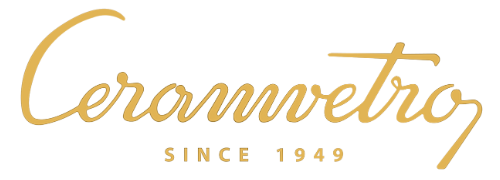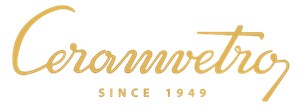Glass Series
Gold and platinum
Key Features
- Ultra brilliance
- Steady lemon colour
- Ultra resistance
- Light smell
- Shiney yellow color also in the internal part
Application
Ceramvetro can supply gold and platinum for hand brushing (it is possible to add 10% of Ceramvetro thinner BD61), for direct printing and for decal production.
For hand brushing application it is recommended to clean and dry perfectly the brush before use.
Firing
- Crystal 510°C – 550°C
- Glass 540°C – 580°C
- Glass bottle 580°C – 650°C
Packaging
100 g, 250 g, 1 kg
Lustres of LUV Series
Key Features
- High stability
- Intense colours
- Long-lasting
Application
Lusters are applied by brushing or spraying. In both cases these lusters must be diluted with our Ceramvetro thinner BD61.
For brushing add about 25% of thinner; for spraying add from 90% to 300% of thinner. The proper pressure for spraying is 0,7 to 1,1 kg/cmq. The object to be decorated should be held at a distance from 15cm to 50cm, depending on its size. The compressed air should be dried to prevent water from entering the luster, which could cause white spots to appear after firing.
Firing
- Crystal 510°C – 550°C
- Glass 540°C – 580°C
- Glass bottles 580°C – 650°C
Packaging
100g (for lustres containing gold), 1kg, 10kg
Thermolustres
Thermolusters are used for the decoration of glass.
Key Features
- Ultra brilliance
- Excellent colour performance
- Long-lasting
Application
Thermolusters are applied by spraying on red hot glass (at a temperatureof more than 800°C before the annealing cycle). No thinner is needed.
In case the decoration result is a light grey the operator must apply more thermoluster; if a white powdery substance appears on the surface of the object after firing, the operator must apply less thermoluster.
Packaging
25 kg
Alabasters
Key Features
- High compatibility with glass
- Intense colours
- Perfect fusion
Application
Alabaster colours are applied during the glass fusion process.
Packaging
25kg in sacks
Crinkles
Crinkles are glass chips made from grinding glass blocks (cold frits), or are produced by quickly cooling a glass block in cold water before milling (hot frits). Glass masters use crinkles to obtain required tones for coloured or uncoloured glass. Other uses include the creation of floor tiles embedded with crinkles.
Key Features
- High stability
- Intense colours
- High compatibility
Application
Crinkles are applied on hot fused glass. They are especially suitable for production by hand and glass blowing.
Packaging
25 kg
Satinglass and Ammonium Bifluoride
Ceramvetro markets glass frosting powders and creams. Satinglass can be used to frost/etch flat glass, glass lampshades, perfume bottles and cosmetic containers.
Key Features
- Extreme softness to the touch
- Ultra resistant to scratches
- Long-lasting
Application
Satinglass is mixed with an industrial grade of hydrochloric acid, to form a glass-etching bath. Before frosting the glass, a pretreatment is useful if the glass surface is dirty or fingerprinted.
The frosting temperature can be varied from 15 to 35 °C (the best temperature is at 25°C).
Packaging
25 kg in sacks
Imitation gold-silver leaf
Metal leaf (gold, silver, and copper) is a thin sheet of metal that can be used in the decoration of wood (such as frames), glass, and ceramics.
Key Features
- Precious metal effect
- High quality
- Uniform colour
Application
After applying a glue (water-based or solvent-based), the leaf can be applied. Afterwards, it is necessary to protect the decorated piece with a spray.
Packaging
Box of 5.000 sheets (silver), box of 10.000 sheets (gold and copper)






